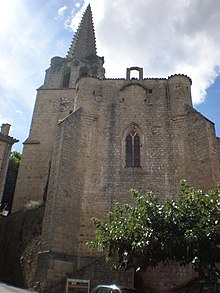Chassiers
| Chassiers | ||
|---|---|---|
|
|
||
| region | Auvergne-Rhône-Alpes | |
| Department | Ardèche | |
| Arrondissement | Largentière | |
| Canton | Vallon-Pont-d'Arc | |
| Community association | Val de Ligne | |
| Coordinates | 44 ° 33 ' N , 4 ° 18' E | |
| height | 193-603 m | |
| surface | 12.26 km 2 | |
| Residents | 1,022 (January 1, 2017) | |
| Population density | 83 inhabitants / km 2 | |
| Post Code | 07110 | |
| INSEE code | 07058 | |
 Memorial in honor of the dead in the First World War |
||
Chassiers is a French commune with 1,022 inhabitants (at January 1, 2017) in Ardèche, in the region of Auvergne Rhône-Alpes . The inhabitants are called Chassiérois (es) .
geography
The municipality extends in the southern part of the Cevennes and borders among others on the municipalities of Largentière and Vinezac . It is part of the Monts d'Ardèche Regional Nature Park . The first foothills of the Tanargue join in the south . The next largest city is Aubenas , eleven kilometers northeast. The village lies along the river Ligne . In addition, the land flows through the municipality.
history
Chassiers was first mentioned in 549 in a document for the conservation of the mines of the Largentière region.
The well-known local historian Albin Mazon also assumes that a male monastery was founded in honor of Saint Benoît by the Bishop of Viviers , Mélianus II. However, the corresponding source disappeared for a long time and, according to Mauzon, was included in the "Charter Vetus" from the 10th century. The text, which was written in the difficult-to-read script of the early Middle Ages, could not be deciphered by most historians. Neither did Père Colombi , who in the 17th century was the first to deal with the documents of the Charter. Another argument against Mauzon's thesis is the fact that no remains or traces of a former monastery can be found in today's municipal area.
On February 26, 1584 the "Brotherhood of the Blue Penitents" (confrérie des pénitents bleus) was founded on the initiative of the feudal lord Louis de la Vernade . The community grew to become the regional power center of the Catholic Church and had to defend itself in 1562 and during the religious wars against attacks by the hostile Protestant minority, the Huguenots . During a battle in 1568, the municipality's castle, the Château de la Mothe-Chalendar , was looted . It had belonged to the wealthy Chalendar family from the 14th century until it was sold to the Rivière family in the 16th century.
Population development
| year | 1962 | 1968 | 1975 | 1982 | 1990 | 1999 | 2006 | 2016 |
| Residents | 665 | 713 | 713 | 854 | 930 | 866 | 966 | 1022 |
| Sources: Cassini and INSEE | ||||||||
Culture and sights
Chassiers is a picturesque place with mostly limestone houses, most of which date from the Middle Ages.
The village is home to two castles. The 15th century Château de la Mothe-Chalendar with a drop bridge and round towers. After it was looted and set on fire by the Huguenots during the Wars of Religion, it was rebuilt in 1568 and 1585. For better protection against enemies, a moat was also built around the facility.
Jacques de Vernade's castle from the 15th and 16th centuries can be recognized from afar due to its large round tower. As a stronghold of Catholicism, numerous meetings of the diocese of Viviers were held here. Today it houses the mayor's office.
There are also two chapels and a church. The chapel of Saint-Benoît des Pénitents Bleus is entirely in the Romanesque style of the late 17th century. This religious community settled there to practice their faith from 1584 until the end of the 19th century. The sacred building was probably built on the site of a former monastery, which led to the first mention of Chassiers. The chapel has two apses and two naves to separate the faithful from the clergy. In 1562 it was also attacked and damaged by the Huguenots.
The 15th century church of Saint-Hilaire , located in the village square, is predominantly in the Gothic style, but is striking because of its strong fortifications. A crypt below the church building, accessible from the outside, houses the local library.
The Notre-Dame de Bonne Rencontre chapel , located a little above the village, is currently being restored. The panoramic view from the higher hamlet of Les Combes attracts many hikers to the place.
Individual evidence
- ↑ a b c chassiers (fr.) ( Memento from August 7, 2014 in the Internet Archive )

